#hijra activist
Explore tagged Tumblr posts
Text
Shabnam Banu
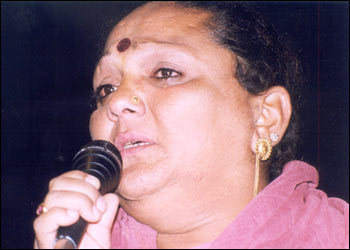
Birth : 1955
Ethnicity : Indian
Occupation : Politician,HIV activist,dancer, trans rights activist,social worker
Alma mater : N/A
Gender : Third gender
Sexuality : N/A
Party : Jeeti Jitayi Politics
Shabnam Bano or Banu is an Indian-born hijra , who is popular by the name Shabnam Mausi. She is also a prominent figure in trans rights movement.
Shabnam was the first hijra person to be elected as MLA in South Asia. She was an active member of the Madhya Pradesh State's Legislative Assembly (from 1998 to 2003). She inspired many hijras/kinners/khawaja saras in India to take up politics and participate in 'mainstream activities' in India, giving up their traditional roles as dancers, prostitutes and beggars.
Early life
Shabnam was born as intersex person in 1955. Shabnam's father gave her a masculine name Chandra Prakash. He was a police and a Brahmin hindu. After Shabnam's birth, he gave her to a local hijra community. Because he thought that his honour could be decreased in the society if someone find out that his child is an intersex.
Shabnam was adopted by Halima, a muslim hijra under the guru-chela kinship.In this matrilineal kinship Halima became her new mother (guru maa) & leader. Her guru nani (hijra grandma in guru-chela kinship) gave her a new name Shabnam Bano. Despite being a hijra, she attended only 2 years of primary schooling. Then she started begging, dancing in marriage & different occasion like other hijras.
Faith
From her early childhood she was raised in an interfaith Hijra dera (household). She practiced a religious syncretism, sometimes worshiping to hindu gods, sometimes praying in the dargah. After leaving the hijra community, Shabnam chosed brahmin lifestyle. Although she kept her muslim name Shabnam Banu.
#third gender#indian#hijra#trans activism#transgender advocate#hijra activist#hindu#cultural muslim#intersex#eunuch
10 notes
·
View notes
Text

Hochemin Islam
Gender: Transgender woman / Hijra
Sexuality: N/A
DOB: N/A
Ethnicity: Bangladeshi
Occupation: Nurse, activist, actress
Note: Bangladesh's first registered trans nurse
#Hochemin Islam#trans femme#transfemme#lgbt#lgbt rights#lgbtq#trans rights#qpoc#bipoc#transgender woman#Hijra#Bangladeshi#asian#poc#nurse#activist#actor#first
105 notes
·
View notes
Text
Violence and Love in Monkey Man

Dev Patel's Monkey Man has played at my mind for two weeks now. This is for reasons that I'm able to articulate and for many that I probably have not yet been able to find the words for. This post is, in part, my attempt at sorting through some of my thoughts. My tumblr is all spoilers all the time. If you don’t want that, then please don’t read on.
Violence
Like most places in the world, systemic violence is a scourge in India. Monkey Man does not shy away from this reality and depicts Hindu nationalist state violence and violence against women and gendered minorities in the country to chilling effect.
We come to see this in the brutal rape and murder of Kid's activist mother at the hands of the police, while she tries to shield her child and her land from police and state terror. We see it in the treatment of (largely femme-presenting) sex workers in the two brothels featured in the film, including one frequented by the police and political elite. We see it in the violence and ostracisation meted out against the hijra, or third gender community by individual actors and the state more broadly. We see it in the state-orchestrated razing of an entire community after the land on which it sits is declared a "holy site". We see it in the movement of people from the regions to the city after their land has been stolen and the grinding poverty they face as a result.

Unlike so many action films, none of the violence in Monkey Man occurs in a vacuum. Even Kid's original means of making money in an underground fighting ring is done against the backdrop of his forced displacement from regional India to the city - a migration pathway that many in the country have been forced to take and which is a direct result of land theft and resource extraction in the regions by local and multinational corporations as well as federal and state governments.
The truth is that so much in relation to state and societal control is enacted in painful and violent ways on the bodies of the marginalised and oppressed. And I often think about how the horror and action genres are some of the best suited to speak about systemic injustice because of their capacity to make that violence uncompromisingly visible (one recent example is Mike Flanagan’s Midnight Mass which depicted the bloody fallout of the Christian missionary/colonial project in vivid crimson, splashed all over a non-descript maritime town in present-day America). The violence in Monkey Man is no different.
While Kid's realisation of the interconnectedness and heavy hand of the state not just in the violence experienced by his mother, but also by the hijra, and by sex workers like Sita comes later in the movie, we as the audience are given this insight earlier. Recall Kid pointing out to Sita that her tattoo is of a koel, not a sparrow as originally misidentified by the Australian client sexually assaulting her minutes earlier in the film.
Kid goes on to say that he grew up in the forest and woke up to koels singing everyday. Its the longest conversation that the two have but in those brief words, we understand that Sita too has likely been displaced to the city from the regions, probably under very similar circumstances to Kid. The way this displacement maps itself onto her body is distinctive to how it does so for Kid, with gender playing a large role in this.

Other factors like caste, class and religion also impact on how the characters in this film experience or perpetrate violence. I would write more on these intersections but then this post is going to get more unwieldy than it already is.
I will say though, that in India, where fascist Hindu nationalism is being used by government to harm minority communities, steal land and secure populist votes, Patel makes a distinction between revelatory and weaponised faith. Kid is raised in peace by his mother with the former, but as an adult he lives in a world where the latter has taken hold and is being used by those in power to shore up more of that power for themselves.
For me - as the descendant of parents, grandparents and great grandparents who lived through anti-Tamil pogroms led by Sinhalese chauvinists weaponising Buddhism as part of their fascism in Sri Lanka, who like the rest of us, is living in an election year for Hindu nationalist Prime Minister Narendra Modi in India, and who is also frustratingly, helplessly bearing witness as the state of Israel and it’s allies conflate Zionism with Judaism in defence of the genocide being waged against Palestinians - watching this action film make the distinction between revelatory and weaponised faith was profound.
Love
Patel makes it a point in this film to show how Kid's most nourishing relationships, the ones that sustain him - indeed the ones that literally save his life - are those that he has with women and with people who don’t conform to the gender binary. In doing this, we see what Kid is fighting tooth (quite literally) and nail for throughout the film. We see what is at stake - what we stand to lose - if perpetrators get to rule without accountability.
Its also no mistake that these relationships are all tied visually to the natural world in the film: Kid's mother's deep ties to the earth, rivers, trees and roots that she leads him through as a child. Alpha and the hijra's sanctuary, the Ardhanareeshvara temple with its most sacred space being the roots of a holy tree. Sita and her koel tattoo: the memory of the forest carried on her skin while she traverses the brutal reality of the city. Patel is making a point here too. About nourishment of another kind, through our connection with the earth instead of extraction from it. The visuals in the film drive this point home, particularly when contrasted with the industrialisation and poverty of the city.
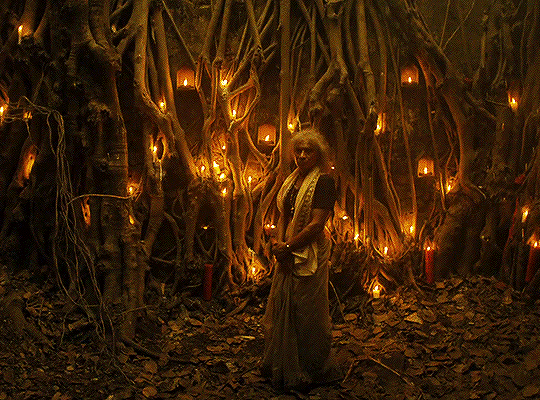
Two particular loving relationships that stood out for me were the love shared between Kid and the hijra community as well as between him and his mother.
Alpha, hijra Elder and the hijra community
Keeper of the Ardhanareeshvara Temple and hijra Elder, Alpha becomes a mother-figure to Kid after he is rescued with near-fatal injuries. It is Alpha who keeps watch over him as he recovers, helps Kid to confront the totality of his past memories which his trauma has kept fragmented, and who ultimately leads a veritable hijra army to join forces with him to assassinate some fascists.
Alpha's gentleness with Kid was so moving to see, in particular during the conversation they have about his attempt as a child to save his mother from the fire set by her rapist and murderer. That exchange moved me to tears.
Kid: I failed her.
Alpha: No. You tried to save her. You see scars. I see the courage of a child fighting to save his mother.

The wider hijra community at the temple also take Kid in and care for him during his recovery. Truly, the scenes at the temple were some of my favourite in Monkey Man. Outside of his memories of his mother, they are the only scenes where we see love, peace and joy on the faces of any of the characters in this film.

Also witness this moment of delight below as the hijra at the temple appreciate a fine ass man channelling his righteous anger and fucking up a punching bag full of rice. I note that the music during this training montage is simply stunning. Ustad Zakir Hussain's rapid fire tablas punctuated by each of Patel's landed punches and kicks and then followed by Jed Kurzel's achingly soaring instrumentals (listen to "The Kid" from the movie's score) were just *chef’s kiss*.

Another favourite moment for me was when Kid decides to go back to the underground fight ring one last time and not throw his matches (as he had been doing prior). He bets on himself and when he inevitably wins his fights, he takes the money and gives it to the hijra, ensuring that they can continue to live at the temple without fear of being evicted. We love to see a man who literally pays his rent.
Neela, his mother
Kid’s first teacher and the center of his life as a child. In almost every memory we are shown of her, Kid remembers his mother walking through a forest, sharing her ecological and religious knowledge with him and in doing so, positioning him within the wider world.

GIF by dailyflicks
We watch as he takes this understanding with him forward through the remainder of the film. His conversation as an adult with Alphonso as they drive through the city in the latter's tuk tuk is emblematic of this. "They don't even see us", Kid says of the elite who frequent the club where he has just gained employment, "they're all up there living and we are stuck in this."
His mother showed him what it was to live: to be still and in concert with the world and the Divine around you, to be loved fiercely, and to thrive as a result. This is in stark contrast to what Kid has had to learn to do in the city: to survive, to merely exist. He is never depicted resting or at home as an adult. He's always working, hustling and planning for the next thing, his next step. When he loses his village, his land and his mother as a child, Kid also inevitably loses his sense of home. It’s no coincidence that the tracks “Home” and “Mother” on the movie’s score sound almost identical.
Later at the end of the film, we see Kid close his eyes, having done what he set out to do. The last thing he sees is his mother, smiling at him in the forest. Her face is the face of God he gazes at before he succumbs to his injuries. This devotion to his mother is not just that of a child to a parent. Its also deeply tied to his Hindu faith which calls on its followers to honour the Divine Mother, the supreme feminine energy, Aathi Parashakthi, in all her manifestations including in those who mother us.
The movie ends with Kid’s deep, revelatory faith - instilled in him by his mother - and with the death of the man who weaponised that faith for power and wealth. It left all of us in the cinema seated in stunned silence even as the credits began to roll.

To describe Monkey Man as simply a revenge film does it an absolute disservice. This is not revenge. It is defence borne out of deep love for community and righteous opposition to injustice. Seeing hijra warriors dressed as Kali, the goddess of destruction, dealing death blows against fascists while spinning in the most beautiful lenghas was exhilarating (I literally screamed “YESSSSSSS!” at the screen when they arrived). Seeing Sita take out pimp and sex trafficker Queenie got me cackling and yelling “whoooop!”. Seeing Kid, a masculine character act to defend women and people outside of the gender binary, from further systemic harm without any ulterior motive was absolutely unreal to witness on the big screen. Seeing a person of faith act in deep connection to that faith without judgment against anyone but those who perpetrate harm made me feel hopeful in a way that took me by surprise. Kid acted out of love and respect. I would argue that Sita, the hijra and Kid all acted out of recognition of a shared humanity.
And at a time when folks from marginalised communities are being subjected to horrendous violence worldwide, both interpersonal and systemic, watching the oppressed take their perpetrators out…and I mean out (see: a rapist and murderer getting bludgeoned to death with a glittery high heel and a fascist, self-proclaimed “holy man” being stabbed in his third eye by the blade he hid in his own “sacred” pathankal/paduka), well, it was cathartic to see.
Am I saying violence is the answer to systemic violence? I think the answer to that question is context-specific. Non-violent resistance has a place, but it’s by necessity a performance and requires an audience. What do you do when no one’s watching? What do you do when the people who are watching are doing nothing to stop your suffering? What then? These questions are what many liberals refuse to grapple with because the answers are too uncomfortable for their polite sensibilities. But if you keep your foot on someone's neck long enough, you should expect them to fight back, by any means necessary. In Monkey Man, we have an action film where we get to witness that resistance in all its visceral glory.
#monkey man#dev patel#jordan peele#vipin sharma#adithi kalkunte#sobhita dhulipala#reva marchellin#dayangku zyana#this post is so fucking long but this movie has been sitting on my heart and my chest for days
131 notes
·
View notes
Note
hello! i saw you talk abt queer desi literature and was wondering if by any chance you know of some queer tamil novel/literature recommendations? totally fine if not, have a great day<3
These are the only ones coming to mind, it's a bit difficult tracking down primarily own voices writing in South Asian queer literature:
The Truth About Me: A Hijra Story by A. Revathi (non fiction, memoir, trans fem author) – this one is a really detailed and powerful story about a Tamil actor and activist who fled her home as a teen and joined a hijra community. it's obviously rather depressing, and not exactly a story of queer joy, because it depicts the lived reality of Indian trans women outside of the urban queer elites, but it's also an incredible story.
Funny Boy by Shyam Selvadurai (fiction, historical, gay author) – a novel about a gay Tamil boy growing up during the 1980s phase of the Sri Lankan Civil war. full disclosure, insofar as my knowledge goes, Selvadurai identifies as Sri Lankan-Canadian (his father was Tamil) and I'm fully aware of how the 2020 Deepa Mehta movie adaptation controversy worsened things, but I took this recommendation from an LGBTQ Tamil blog online. I did not particularly enjoy Cinnamon Gardens by the same author, tbh.
Hungry Humans by Karichan Kunju (fiction, novel, historical) – first published in 1977, it deals with two Tamil characters, one of whom is grappling with homosexuality, greed, consuming desire and abuse trauma. I have not read this book, with full transparency, and the reviews are very mixed, with some Tamil reviewers saying that while the themes explored are compelling, the writing and authorial stances feel a bit dated, especially on issues of caste.
Siren's Desire by Samirah the Sapphic Siren (poetry, sapphic author)– this is a poetry collection by a Tamil Dravidian sapphic visual artist and poet that centres brown QTPOC as bodies who actively desire, and are not just passive objects tokenized for their desirability. Tackles themes of intersectional queerness, colorism, and healing from trauma. Btw you can directly support Samirah here (shop link) and here (patr30n), as well as on instagram (@/thesapphicsiren).
The First Beautiful Woman In The World by Leena Manimekalai (poetry, bisexual sapphic author)– this is a bisexual poetry collection by a Tamil writer, activist and director who has created several works depicting trans and/or queer identities in an Indian Tamil societal context. Unfortunately, I wasn't able to find English translations of her works; she has more than one sapphic poetry collection apparently, but I could not track a single work down online (if any Tamil followers can help out it will be great!). you should follow her on Instagram nevertheless and support artists who vocally support the voices of marginalized communities and resist alt-right fascist censorship.
#answered ask#yioh#mimiwrites#book recs#books#book recommendations#desi#desiblr#desi queer#lgbtq books#gay#lesbian#bisexual#trans authors#sapphic authors#litblr#translated literature#bookblr#lgbtq
147 notes
·
View notes
Text
List of notable Muslim allies of queer, trans or LGBTQI+ folks
Imam al-Nawawi – ally of Mukhannathun or trans femmes, female transsexuals and effeminate queers
Saint Khawaja Gharib Nawaz – ally and patron of Hijra and Khawaja Sara communities
Saint Baba Bulleh Shah – ally and patron of Muslim Khawaja Sira communities
Saint Lal Shabaz Qalander – patron of Khawaja Sira & trans Muslim communities
Abu Muhammad Ali Ibn Hazm – ally of queer Muslims
Ayatollah Ruhollah Khomeini - ally of transgender & intersex folks
Sheikh Muhammad Sayyid Tantawi - ally of trans & intersex folks
Amina Wadud - ally of LGBTQI+ Muslims, founder of Queer Islamic Studies and Theology (QIST)
Gulbanu Khaki/Gul Khaki - ally of LGBTQ+ muslims, mother of a gay imam
Khaled Hosseini - ally of transgender & proud muslim dad of a transgender child
Siddika Jessa - LGBTQI+ activist, mother of a gay muslim son
Ani Zonneveld
Pamela Taylor
Laura Silver
Omid Safi
Kecia Ali
Ghazala Anwar
Ensaf Haider
Saleemah Abdul-Ghafur
Farid Esack
Zaitun Mohamed Kasim/Toni Mohamed Kasim
Anne-Sophie Monsinay
Imam Kahina Bahloul
Imam Philip Tuley
Scott Siraj al-Haqq Kugle
Farouk Peru
Abdennur Prado
Ingrid Mattson
Hasan Minhaj
Reza Aslan
Alia Bano
Zaid Ibrahim
Azahn Munas
Ayman Fadel
Inayat Bunglawala
Shahla Khan Salter
Nakia Jackson
Jeewan Chanicka
Taj Hargey
Michael Muhammad Knight
Maajid Nawaz
Shehnilla Mohamed
Mustafa Akyol
Writer Sabina Khan
Activist Jerin Arifa
Urvah Khan - LGBTQI+ ally, co-founder of Muslim Pride Toronto
Imam Khaleel Mohammed
Imam Tareq Oubrou
Imam Dr Rashied Omar
Shaykha Fariha Fatima al-Jerrahi
Shaykha Amina Teslima al-Jerrahi
Scholar Hussein Abdullatif
Maysoun Douas
Fátima Taleb
Aydan Özoğuz
Omid Nouripour
Özcan Mutlu
Ekin Deligöz
Cem Özdemir
Artist Nadia Khan
Marina Mahathir
Siti Musdah Mulia
Karima Bennoune
Grand Mufti Sheikh Assadullah Mwale
Muneeb Qadir
Dr. Amir Hussein
Dr. Sana Yasir
Dr. Sali Berisha
Dr. Omer Adil
Hashim Thaçi
Albin Kurti
Supermodel Nadia Hussain
Irish-Bangladeshi singer Joy Elizabeth Akther Crookes
Salma Hayek
Fouad Yammine
Pakistani Director Asim Abbasi
Pakistani Actress Nadia Jamil
Indian Actor Saqib Saleem
Indian Actor Irrfan Khan
Indian Actor Aamir Khan
Indian Actress Zeenat Khan/Aman
Indian Actress Shabana Azmi
Indian Actress Saba Azad
Indian Actress Sara Ali Khan
Indian Actress Huma Qureshi
Indian Director Zoya Khan
Pakistani Actor Furqan Qureshi
Bangladeshi Actress Azmeri Haque Badhon
Actor Muneeb Butt
Indian Actress Zareen Khan
Indian Actor Imran khan
Pakistani Actress Mehar Bano
Filmmaker Faruk Kabir
Filmmaker Saim Sadiq
Filmmaker Sharmeen Obaid-Chinoy
Riz Ahmed
Zayn Malik
Sally El-Hosaini
Malala Yousefzai
Hafid Abbas
Hojatoleslam Kariminia
Singer Sherina Munaf
Writer Alifa Rifaat
Writer Ismat Chughtai
Activist Nida Mushtaq
Activist Aan Anshori
Abdul Muiz Ghazali
Kyai Hussein Muhammad
Marzuki Wahid
Gigi Hadid
President Abdurrahman Wahid (Gus Dur) - ally of waria or transgender females
Sinta Nuriyah - ally of trans & waria folks
Politician Keith Ellison
Mayor Sadiq Khan
Politician Ilhan Omar
Politician Rashida Tlaib
Politician Rushanara Ali
Politician Nabilah Islam
Politician Shahana Hanif
Politician Rama Yade
Politician Humza Yousaf
Politician Zarah Sultana
UK Sectratary General Zara Mohammed
Turkish politician Kemal Kılıçdaroğlu
Bengali Influencer Sobia Ameen
Shaykh Michael Mumisa
Muhammad Musharraf Hossain Bhuiyan
Mufti Abdur Rahman Azad - Hijra ally
Sheikh Hasina - Ally of hijra-intersex communities
Lawyer Iftikhar Chaudhry
Amani Al-Khatahtbeh
Professor Amel Grami
Professor Muhammad Aslam Khaki
Mohammad Hashim Kamali
Mehrdad Alipour
Lawyer Imaan Mazari/Iman Mazari
Shireen Mazari
Syed Murad Ali Shah
41 notes
·
View notes
Text
Revathi - A Life in Trans Activism by A. Revathi and Nandini Murali

When Revathi’s powerful memoir, The Truth About Me, first appeared in 2011, it caused a sensation. Readers learned of Revathi’s childhood unease with her male body, her escape from her birth family to a house of hijras (the South Asian generic term for transgender people), and her eventual transition to being the woman she always knew she was. This new book charts her remarkable journey from relative obscurity to becoming India’s leading spokesperson for transgender rights and an inspiration to thousands.
Revathi describes her life, her work in the NGO Sangama, which works with people across a spectrum of gender identities and sexual orientations, and how she rose from office assistant to director in the organization. Today she is an independent activist, theatre person, actor and writer, and works for the rights of transgender persons.
In the second part of the book, Revathi offers the reader an insight into one of the least talked about experiences on the gender trajectory: that of being trans men. Calling several female-to-male trans persons her ‘sons’, Revathi puts before us their moving, passionate and sometimes tragic stories of marginalization, courage, resistance and triumph.
An unforgettable book, A Life in Trans Activism will leave the reader questioning the ‘safe’ and ‘comfortable’ binaries of male/female that so many of us take for granted.
#revathi#revathi - a life in trans activism#a. revathi#nandini murali#trans book of the day#trans books#queer books#bookblr#booklr
21 notes
·
View notes
Text

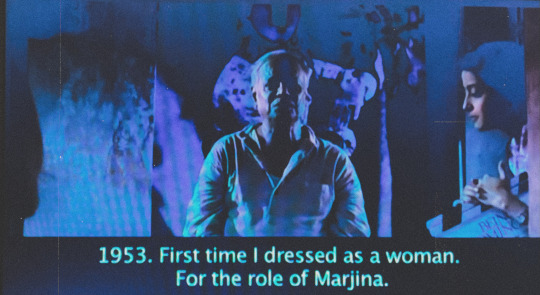

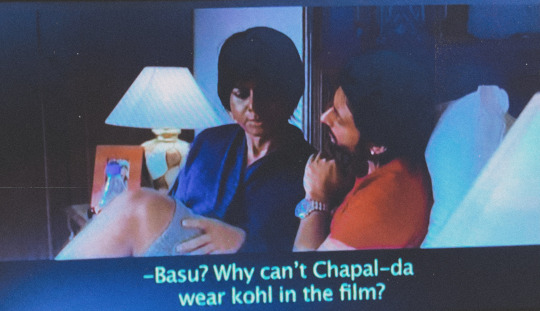


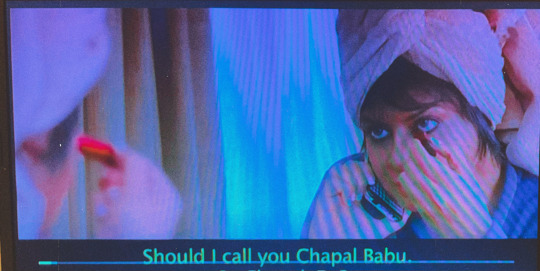
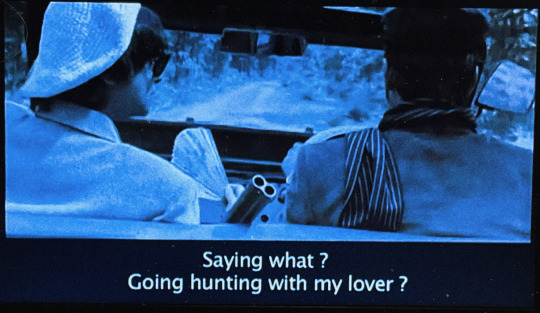


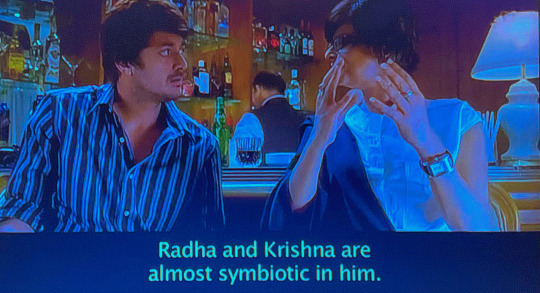
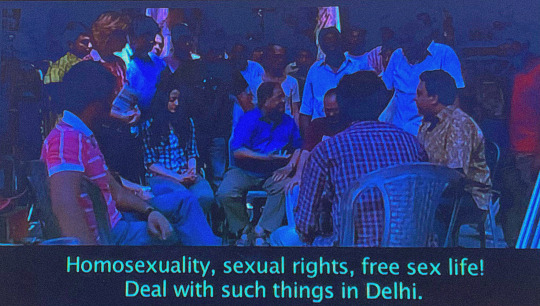
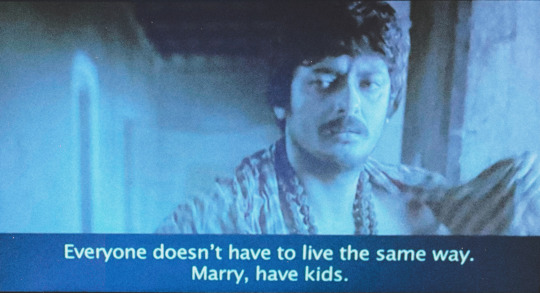
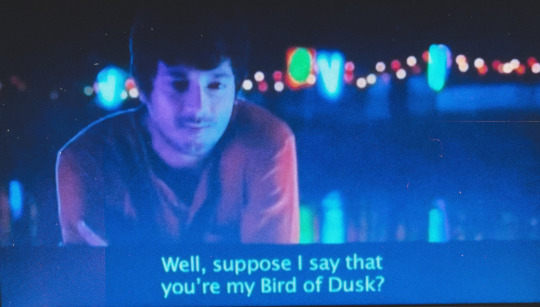


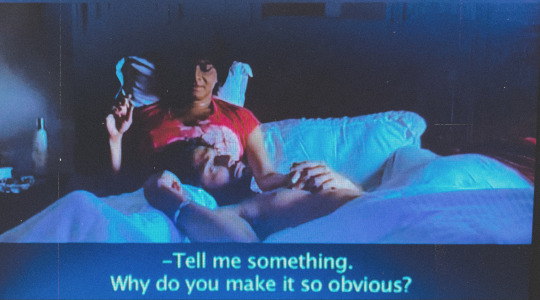
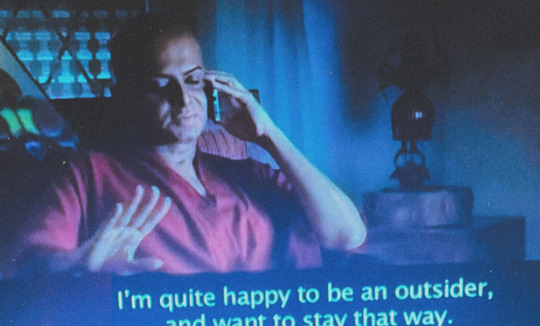


Arekti Premer Golpo (2010)/// Rituporno Ghosh
As a brown skinned queer girl, born in a country where identifying as *not straight* will get you to jail, I really didn’t have much icons to look up to growing up. The activists in the only formal LGBTQ organisation in our country were all killed off in 2013 (a hushed topic no one knows), so it’s scary as hell. Classmates calling me *hijra* because I liked girls along with boys. Frenemies sending me advice articles on *how not to be gay*. Juniors laughing at my *gender identity* and pronouns. I’ve had it all.
My mom always liked Rituporno Ghosh, saying his films equate to art, but would never show me who he was. Why? My young self wandered off and researched him up a bit. I was shocked to find an androgynous role model, a person who shared the same skin tone as me. It might sound silly today, but it surely meant a lot to the 13 year old fuddled up about her identity in the world.
Years have passed. I’m comfortable in my own skin. I’ve learnt to cut off remarks that do not matter. Ex boyfriend texted that I *looked gay* in a certain Instagram post, I replied *omg thanks <3*. Pansexuality has become such a deep part of me today that it doesn’t feel different. I’m the same human, ok?
I decided to watch up Rituporno’s most iconic film today. It is not a very *talked about film* in the Bengali industry.
Rituporno introduces melancholy as the main theme of the entire story. A gay man wanting to hide behind the story of the film he’s making. Being in love with someone he can’t have forever. As “Basu” describes in a shot, they’re lovers on the run.
Drawing from historic references and *Jatra*, he also explores the androgyny in the Bengali traditions. It magnifies the aesthetic appeal of the film even more. Lovely lovely camera work.
One of the main successes of the themes of “Arekti Premer Golpo”, in my opinion, is that it is close to reality than most other queer stories. The other upbeat netflix series stuff show a very utopian world where LGBTQ lovers live in an accepting world, almost isolated to only themselves. But Rituporno illustrates complex relationship dynamics in his films, leaving the audience to wonder the real chemistry between them (I still need to research).
It’s brain food, it’s thoughtful. I love it.
absolutely 9/10.
@jukti-torko-golpo @amar-hiyar-majhe @shubhadeep385 @il-ragazzo @gorgpearllatte @augustineprime @dewaniiiii @faewong
#Films#lgbt#lgbt pride#queer#queer community#queer films#light academia#dark academia#desi girl#desiblr#girlblogging#gaslight gatekeep girlblog#this is a girlblog#Rituporno ghosh#bengali#bengali films#movies#cinema#movie review#bengaliblr#indian tumblr#indian#west bengal#bangladesh#queer rights#lgbt rights#lgbtqia rights
12 notes
·
View notes
Text
Homosex Regimes
I walk the rest of the way alone. Pramod was right; the figure is indeed Kamal, my neighbor, whom I've known for several years. He sleeps outside his family's house in the lane; he is the youngest of several brothers, who are mostly tailors; he has held several jobs during the time I have known him; he has been fired from a soap factory and now works on odd tailoring jobs with his brother and several other tailors; he supplements his meager income, as before, by cruising street corners in this part of the city, in men's clothes but with a bend of the waist -- lachak -- and jiggle of the bottom -- mathak; he hangs with a group of sahelis, who often dance for weddings, in saris, somewhat like hijras. "They do births; we do weddings," Kamal once said of the difference between him and the girlfriends on one hand and hijras on the other. "Where are you coming from?" he laughs. I evade his question, and tell him his friend Ram Prasad, whom he sometimes calls Rita, has been bothering me, stopping me on busy roads in broad daylight and making passes. With sahelis, Kamal calls himself Kamala. "And what am I called?" I once pleaded somewhat pathetically, afraid to be out of the loop. "You, you're called my husband," Kamala returned. "But I don't want to be your husband." "Yes, you do, of course you do. And what else could you be?" "Your friend… your saheli." "You can't be my saheli, you're too siddhe-sada [straight and regular]…" I perhaps misread "straight," and responded: "What do you know? I have a husband in America." "Oh, that again." "Why won't you believe me? I do." "You really want to be a saheli?" "Do I look like I want to be your husband?" "Well. We'll see. We'll call you Anita. Anita Devi." [1]
The 20th century gay search for history saw transfeminized groups enlisted as highly visible and global examples of male homosexuality. Combining the anthropological "third gender" obsession with longstanding USAmerican "gay tourism" practices in Latin America and Southeast Asia, academics like Lawrence Cohen, Don Kulick, David Valentine, and Tom Boellstorff performed long-term fieldwork with transfeminized groups alongside and through the burst of NGO global health scholarship that came with the AIDS epidemic. The opening vignette is one product of this strange joining, and Cohen’s uncertainty is not just a question of academic-race-class divides [2], although that's certainly part of it. Rather than being held to the standards of the groups they were working with, masculine gay academics like Cohen and Kulick were much more tractable as "trade" or "panthis" or "husbands," the quasi-marked group of 'straight men' that transfeminized groups tended to fuck. The ideal of ethnography is "participant observation," sharing the long-term rhythms of everyday life and work with a group, and while Kulick et. al certainly fucked, they were fitting in and "participating" as a very different group than the people they were studying. This is a collection of a few of these moments of awkwardness, points where several different regimes of homosex-gender rubbed shoulders with each other.
David Valentine is probably the scholar that engaged with this most intentionally. His 2008 text Imagining Transgender: an Ethnography of a Category traces "transgender" as it emerged from Bay Area activism out through the rest of the US, carried in large part by NGO and activist institutions. He begins the book with one of these moments of friction:
‘‘I’ve been gay all my life, been a woman all my life,’’ says Fiona. I am sitting with Fiona and five other people around a table at the semi-monthly support group for transgender-identified people with HIV at New York Hospital in Manhattan. Two of us—myself and James, the group facilitator—identify as non-transgender gay men and are white, male-bodied, middle-class professionals. The other five, including Fiona, though born male, present themselves and live their lives as feminine people and are either African American or Latina. However, although the group is billed as a transgender support group, none of the participants routinely refer to themselves as transgender. More often, they talk about themselves as girls, sometimes as fem queens, every now and then as women, but also very often as gay, this category being one I share with them in talking about myself. ... This is not to say that Fiona and her peers did not make distinctions between themselves and other kinds of people, though. This became apparent when I turned up for the next meeting two weeks later. With great sensitivity for my feelings, the participants told me that it might be best if I didn’t attend the group anymore. Not everyone felt this way: Diana said she didn’t mind if I attended because ‘‘we’re all gay.’’ However, Frederique, speaking for the majority, said: ‘‘You aren’t a girl, you don’t have boobs and this figure,’’ motioning down her body with her hands. ‘‘With you here, there’s another man in the room.’’ Even though Diana, Frederique, and other members of the group had spent much time jesting with me about our common identification as ‘‘gay,’’ it was clear that being ‘‘gay’’ meant something different for me and them.[3]
While nearly every one of these academics were deemed only partially 'gay' because of their masculinity, Valentine was the one to make a book out of it. He focuses almost entirely on how people answered direct and indirect questions about gay / woman / butch queen / fem queen / TV / TG / TS status, and while he is nominally interested in "transgender," that term mostly just appears in his literature review. He's very distant for an ethnographer (and of all of them, I think he was probably the only one that didn't fuck), but the book is still good for both the institutional trace and the actual systemic grounding of "transgender."
Don Kulick brings lesbians into the picture. While he does express plenty of the standard trade anxiety (above) in his 1998 book, there's something especially interesting in his certainly named article "Fe/male Trouble: The Unsettling Place of Lesbians in the Self-images of Brazilian Travesti Prostitutes:"
Keila is here expressing an opinion that I found to be prevalent among travestis in Salvador. Numerous stories circulate among travestis about how lesbians are attracted to them. Almost any travesti can tell stories about how lesbians have come on to them. One travesti told me that several lesbians who lived on the same street as she were 'impassioned' (apaixionadas) with her, one so much so that she would 'go up to the sky and take down the moon' if the travesti wanted it. Another woman once told me that she was having a clandestine relationship with a woman who she said was a lesbian (This travesti was a notorious liar and other travestis to whom I mentioned this doubted that it was true. What is important in this context, however, is that the speaker stressed that the woman was a lesbian). Yet another individual who lived for years as a travesti, and who has prominent breasts from years of hormone consumption, but who now dresses in male clothing and considers himself to be 'bisexual,' lived for 6 years with a woman who works as a prostitute and who is considered by everyone (including, I am told, by herself) to be a lesbian. And the occasional woman who accompanies her husband when he seeks out the sexual services of travestis is always considered by travestis to have 'something lesbian in her disposition' (um quê de lesbica na mente dela). I have no idea of the extent to which Brazilians seeing a travesti in male clothing will actually identify that travesti as a lesbian. The point is, however, that travestis themselves are convinced that they are seen in that way. What is more, there are occasions on which they see one another in this way: two travestis living together as a couple (something which in fact occurs only extremely rarely in Salvador) are talked about as a lesbian couple, and one of the words used to describe the kind of sex they are publicly imagined to be having is roça-roça (rub-rub) -- the same word used to describe lesbian sex (the other expression used to describe this kind of sex is quebrar a louca -- literally 'break the china,' an expression whose meaning I am still puzzling over).[4]
More broadly, the piece argues that "travestis interpret lesbians as commentaries not primarily on femininity, but rather as on travestis. They see lesbians as 'caricatures of tranvestis' (uma caricatura do travesti)." This isn't especially interesting, and Kulick kind of hates the people he's working with, but it's at least quite in the weeds. One thing that strikes me is the way the dick is positioned in many of these anecdotes: several travestis Kulick cites "just don't get" lesbianism because unlike with gay men, there's no dick to use, and Kulick ultimately argues that his travesti acquaintances believe lesbians want them for "one distinctive male body part;" whether or not that's true in the way Kulick describes, the travestis he speaks to certainly see themselves as objects of lesbian desire:
I asked Keila if she perhaps didn't feel comfortable around lesbians because lesbians didn't like travestis. Her reply was completely unexpected: 'No,' she said, 'the worse thing is that they like them more -- I think here in Salvador, lesbian women look at travestis as instruments of pleasure. They are turned on by travestis.' [4]
There is something else in this piece about "caricature," but to end this let's look at Tom Boellstorff's 2005 text "The Gay Archipelago," which provides a few good anecdotes from yet another direction. Boellstorff is predominantly concerned with gay men in Indonesia, and he spends the text contrasting them sharply with warias, a transfeminized group that coalesced over the 60s and 70s in postcolonial Indonesia; "waria preexisted gay, but they now form a binarism making thinkable a noneffeminate male homosexuality." His work with Indonesian gay men constantly navigated this tension:
During my Surabaya fieldwork I conducted three focus groups bringing together approximately ten gay men for an evening in a neutral environment. Toward the end of one focus group a debate broke out between the members of the group and Faisal, a gay man who assisted me in moderating the groups. We were discussing marriage when the focus group members asked if Faisal or I would ever marry. My negative reply brought surprised looks, but it was Faisal’s firm contention that he would never marry (“because I am gay after all”) that brought an air of distress to the room. No one was more upset than Ikbal, a friend of Andy who was married to a woman. “Maybe you are more modern and liberal, Faisal. I am absolutely in disagreement and unhappy with your decision. I’m sure you could do it with a woman if you tried.” “Ikbal, I think you are biseks,” Faisal said, using a term unfamiliar to most gay men that reflected his work in HIV prevention. “But I only became able to have sex with a woman after I got married. You’ve already condemned yourself to be gay,” Ikbal replied. Murmurs broke out around the room. One person said, “I think that Faisal is really waria, not gay, because he never plans to marry.” Ikbal leapt on the statement: “Faisal, the problem with you is that you don’t want to take any steps toward being normal. You’re being shallow.” Then, in exasperation, Ikbal turned to me: “I just can’t imagine you not getting married, Tom. I’m trying to understand it, but my mind just can’t believe it. I’ve always assumed that all men get married, even warias, even gay men.” [5]
Boellstorff and Faisal consider heterosexual marriage to detract from 'gay' identity, but this contrasts messily with the way that gays distinguished themselves from warias: as Boellstorff notes, "most gay and lesbi Indonesians marry “heterosexually” and may not see this as inconsistent with being gay or lesbi," while warias "are the only major class of persons beyond the disabled who are not typically pressured to marry heterosexually." Heterosexual marriage positively forms gay identity by distinguishing married gays from unmarried warias, but it simultaneously serves as a marker of difference from Boellstorff's unmarried transnational gay, a constant threat of being deemed bisecks. Boellstorff talks a lot about marriage in the text -- it is a major difference between his gay and the gay of many of his interlocutors, and a difference that is being actively targeted by an AIDS NGO focus on super-spreading bisecks men -- and it's also almost certainly informed by the book having been written before any major US gay marriage laws (homonationalism etc). One interesting comparison would be Howard Chiang's Transtopia in the Sinophone Pacific, which discusses gay groups and activism after the 2010s. That's all.
Although waria do have sex with each other on occasion, they tend to regard this as strange, and they joke good-naturedly that it is “like a woman sleeping with a woman.”
Footnotes
Lawrence Cohen, "The Pleasures of Castration," in Sexual Nature, Sexual Culture.
One interesting example of this on the lesbian end can be seen in Sabine Lang's "Travelling Women; Doing a Fieldwork Project on Gender Variance and Homosexuality among North American Indians."
David Valentine, "Imagining Transgender: an Ethnography of a Category"
Don Kulick, "Fe/male Trouble: The Unsettling Place of Lesbians in the Self-images of Brazilian Travesti Prostitutes:"
Tom Boellstorff, "The Gay Archipelago"
6 notes
·
View notes
Note
People will really discount everything an activist has to say because they dare to actually have a definition for man and woman, and then go ahead and promote Ghandi as a beacon of righteousness
I bet Gandhi himself wouldn't agree with 10% of what these people have to say, but he is of course the best person to ever have walked the earth lmao. (also note how these people never talk about Nehru? when he was at least as important as Gandhi imo)
and before people now come here and tell me about Hijras: Hijras are gay men who dress and behave in a certain way. Not even in Indian culture Hijras are identified as women. They also don't become Hijras by self-identification, but by different initiation rituals. they have literally nothing to do with being transgender.
18 notes
·
View notes
Text
The history of the acronym ‘LGBTQIA+’
The acronym ‘LGBTQIA+’ is used to describe those identifying outside of the gender and sexuality norms. The acronym stands for ‘Lesbian, Gay, Bisexual, Transgender, Queer, Intersex, Asexual/Aromantic, plus’ each of which is a separate identity within the community. But how did this acronym come to be? And how can an acronym be so defining of a cause?
The term ‘homosexual’ had gained a negative connotation in the United states of America, even now it is only used in specific circumstances. The word ‘Gay’ then filled the linguistic gap and gained popularity in the 1970s, as it did not refer explicitly to sexual activity. As time went on, the word ‘Lesbian’ also became more widely known. However, disputes over what the main political aim should be; gay rights or feminism, led to a large number of lesbians branching off. This created other, smaller, social groups; one such example being the ‘Daughters of Bilitis’ who were the first lesbian civil rights activists. They eventually disbanded due to the idea that ‘butches’ and ‘femmes’ were heteronormative and patriarchal.
In the late 1970s or early 1980s, there was a push for bisexuality and transgender inclusion. After the relief felt post the stonewall riots, there was less acceptance of bisexuality leading to the misguided belief of bisexuals being men or women too scared to come out as gay. Transphobia was also common with the idea that these people were simply upholding stereotypes and traditional norms. These beliefs have been carried forth by parts of the community even to modern day, with the idea that ‘Transgender’ should be removed from the acronym.
Around 1988, the acronym ‘LGBT’ had solidified as a term used for the queer community throughout the United States. Since then the acronym has evolved and adapted to be more inclusive of an increasing number of marginalised groups, each adaption carries controversy with it.
The addition of the letter ‘Q’ includes ‘queer’ or ‘questioning’ people into the community. The word ‘Queer’ was often used as an insult and has since been reclaimed by the community. This has led to the development of ‘LGBTQ’ and ‘LGBTQQ’, however many believe that the word ‘queer’ should not be associated with the community and this argument has carried over to this day.
Around the same time, ‘GLBT’ came into existence– this was fundamentally the same, but had ‘Gay’ in front of ‘Lesbian’. The order in which the letters appeared was not standardised in any way which led to international discrepancies between the queer communities, Spain uses LGTB due to their specific preferences.
Other sexualities and gender identifications were recognised under the label of either bisexual or transgender. This is when the use of ‘LGBT+’ began gaining popularity since it meant ‘lesbian, gay, bisexual, transgender, and all other related identities’, others began using a letter like ‘U’ for unknowing, or ‘C’ for curious. There was a pull in many directions with a call for the addition of an ‘H’ for ‘HIV infected person’, a ‘P’ for those in polyamorous relationships, and an ‘O’ for ‘other'.
In 1990, the community and activists began to take in different cultures’ approaches to gender. ‘TS’ or ‘2S’ was used to represent ‘Two Spirit’ people, these are people indigenous to America who use to describe people fulfilling a traditional third gender. In India, ‘LGBTIH’ is sometimes used to include the third gender of ‘Hijra’ and related identities.
At this point, it becomes difficult to pinpoint when exactly the acronym evolved as it was happening through speech alone. Sometime during the early 2010s, the addition of ‘Intersex’ was controversial as many believed that it should fall under the ‘transgender’ label. Intersex people, too, were against the addition as they believed it impeded the progress being made on the rights of intersex people. Julius Kaggawa of the SIPD Uganda wrote that while the queer community ‘offers us a place of relative safety, it is also oblivious to our specific needs’. Emi Koyama has written that the LGBT community could fail to recognise intersex-specific struggles.
In roughly 2015, aromanticism and asexuality became more accepted and understood and joined the community and therefore the acronym. The ‘A’ in ‘LGBTQIA+’ stands for ‘Asexuality’, ‘Aromanticism’, ‘A-spec’, and ‘Agender’, as well as the related communities. People outside the community have claimed that the ‘A’ stood for ‘Ally’, which was met with immediate contradiction as it was erasure of part of the queer community.
The acronym is still debated to this day as many use a shorter version; ‘LGBTQ+’ and others argue that it is queer erasure. People still call for the removal of transgender as they believe the community should be focused on sexuality, and there is still bisexual and asexual erasure by a large party within the community. However, ‘LGBTQIA+’ is recognised as the full acronym to describe the queer community.
Sources: ‘The Handbook of Lesbian, Gay, Bisexual, and Transgender Public Health: A Practitioner's Guide to Service’ by Michael D. Shankle, ‘Sipdug.org’, ‘The Transfeminist Manifesto’ by Emi Koyama, ‘From LGBT to LGBTQIA+: The evolving recognition of identity’ by Erin Blakemore.
6 notes
·
View notes
Text

First of all I am sick of people appropriating AAVE, especially in an insulting way.
2) So these people have a problem when generally others find it tedious to use long or ludicrous terms (example- uterus owners, people with estrogen based endocrine system) instead of simply "women" to describe something only the female sex experiences in a patriarchal system.
But now it's "transparently transphobic" to even categorize social experiences by sex (idc if you believe sex is biologically immutable or just a social construct but if you believe there's no sexual inequality on basis of sex then you're just unbelievably stupid).
If you go through the notes you will see the brain rot there.
What actually pisses me off about this tho, and why I felt like ranting about it here, is that these people tokenize third gender culture and feminism of brown women ALL THE TIME.
(Despite them certainly knowing hijras are exclusively males and there is a history of the patriarchy's role in creating some of them but they somehow see it as gender liberation.)
If they actually found out how "afab" people (LBT- Lesbians, Bisexual women and Trans men) from our country's LGBT community form organizations only for those who are female because we recognize misogyny is sex based and how "amab" people hold more privilege, they will freak out.
They will freak out when they find out we recognize homophobia is sex based oppression too. Our laws literally specify people of same sex cannot marry regardless of gender identity, meaning a trans woman cannot marry a cis man and same for trans men and cis women unless said trans people undergo complete SRS. And the ability to pay for it is a privilege only middle and upper class same sex attracted people who haven't been shun out by their families enjoy.
It is literally necessary for us to organize on the basis of sex to get our rights.
Despite all this fucking bullshit, we're being asked to focus more on trans people than on "love is love". That India's LGBT activism is not trans inclusive enough (I hate these stupid white bootlicking libfems sm) because our activism doesn't look like the West's.
Ik op is not Indian but the amount of both Indian liberals who fall for this bs....although Indian radfems are not less guilty of indulging in bootlicking white people and Western activism, both responding in bad faith to each other while knowing absolutely NOTHING about their own country's history and activism regarding gender and sexuality. My views are still very different even according to Indian LGBT activists' beliefs, and yet I have more respect for them instead of fuckers like you who think online content creation is fighting for "queer rights".
Like girl, our activists were fighting even during a time when terms like "lesbian", "bisexual", "queer" etc were not known and used here. Ik for a fact you were introduced to gay and trans activism via Western media but I swear we have our own history and community and you do NOT need to nod your head to whatever these idiots say.
How can you believe this bullshit despite coming from a country where female infanticide occurs because daughters are seen as a "burden" to their fathers?
Postmodernism along with US cultural imperialism is a fucking disaster.
#I have come across hijras who believe they are privileged compared to women and that the female sex experience is different from theirs#and I don't even like how hijras talk about womanhood at all but they are genuinely so much less worse than trans people who follow Western#gender ideology#desi lgbt#lgbt india#desi feminism
18 notes
·
View notes
Text

Nazrul Islam Ritu
Gender: Transgender woman / Hijra
Sexuality: N/A
DOB: 15 June 1979
Ethnicity: Bangladeshi
Occupation: Activist, politician (Independent)
Note: She is the first hijra (third gender) elected union parishad chairperson in Bangladesh
#Nazrul Islam Ritu#lgbt#lgbt rights#trans rights#lgbtq#lgbt people#transfemme#trans femme#transgender#trans woman#third gender#Hijra#1979#Bangladeshi#asian#poc#activist#politician#first
58 notes
·
View notes
Text
The history of transgender people
The history of transgender people is complex and varied, stretching back to ancient civilisations and continuing through to the present day. While there is no single narrative that can capture the full breadth of transgender experience, there are certain key moments and figures that have helped shape our understanding of gender identity and expression.
One of the earliest recorded examples of transgender identity comes from the ancient Sumerian civilisation in Mesopotamia, where priests and priestesses of the goddess Inanna would sometimes dress in clothing associated with the opposite sex and perform rituals that blurred traditional gender boundaries. In other cultures, such as the Native American tribes of the Two-Spirit tradition or the hijra communities of India, individuals who did not conform to traditional gender roles were often revered as having special spiritual or healing powers.
The modern concept of transgender identity emerged in the mid-20th century, when medical professionals began to recognise that some people experienced a persistent and distressing sense of incongruity between their gender identity and the sex they were assigned at birth. This led to the development of gender-affirming medical treatments such as hormone therapy and gender confirmation surgery.
One of the earliest known examples of gender-affirming medical treatment took place in Germany in the 1920s, when Dr. Magnus Hirschfeld established the Institute for Sexual Science in Berlin. The institute offered medical and psychological support to people who experienced gender dysphoria, as well as advocating for legal and social recognition of transgender identity.
Unfortunately, the institute was destroyed by the Nazis in 1933, and many of its patients and staff members were killed or forced into hiding. It was not until the 1950s and 60s that transgender identity began to be more widely recognized in Western medical and psychological circles, thanks in part to the pioneering work of researchers such as Dr. Harry Benjamin.
In 1952, Benjamin published "The Transsexual Phenomenon," which outlined a clinical framework for understanding and treating gender dysphoria. He argued that transgender people should be allowed to access medical interventions such as hormone therapy and gender confirmation surgery in order to align their bodies with their gender identity, and he helped establish the standards of care that are still used by many medical professionals today.
Throughout the 20th century, transgender people faced significant discrimination and marginalisation, particularly in the United States. Laws and social norms restricted their access to healthcare, education, employment, and other basic rights, and they were often subject to harassment and violence.
In the 1960s and 70s, however, transgender activists began to organise and advocate for their rights, paving the way for greater recognition and acceptance of transgender identity in the decades that followed. In 1975, for example, the first international conference on transgender rights was held in Atlanta, Georgia, bringing together activists from around the world to share their experiences and strategies.
Today, transgender people continue to face many challenges, including discrimination, violence, and lack of access to healthcare. However, there have also been significant gains in terms of legal protections and social acceptance, particularly in many Western countries. Transgender celebrities such as Laverne Cox and Caitlyn Jenner have helped to raise awareness and visibility of transgender issues, and many organisations and advocacy groups are working to promote transgender rights and equality.
The history of transgender people is one of resilience and resistance, as individuals and communities have fought to assert their identities and secure their rights. While there is still much work to be done, the progress that has been made in recent decades provides hope for a more inclusive and just future.
#trans#lgbtq+#lgbtqia+#lgbtq#transgender#ftm#nonbinary#nonbinarymemes#transpride#transpositivity#protecttranskids#lovetranskids#transkids#transyouth#supporttranskids#lgbtq+pride#transgender pride#transfamilies#transparent#transrights#transkidsarekids
11 notes
·
View notes
Text
The thing is, again, a lot of the people from the "hijra" community have reclaimed the word, even though it is still used in a derogatory manner. So whether or not it's okay to use the word is debatable, and frankly, not something I can answer. A lot of them do call themselves hijras, and I've heard the term khwajasira be used by the community as well, usually in a more positive light than hijra, so I think that can be an acceptable substitute.
My main point with the tags was just that westerners tend to ignore the nuances of these cultures and the way that the words used to describe genderqueer people are perceived in these societies when they speak about our "third genders". You majored in queer studies, so I'm sure you understand better than most people how gender is a social construct and therefore changes depending on the society. Most westerners tend to ignore the society that these "third gender" people live in very often, just focusing on the concept and not how it interacts with the culture around it.
Because khwajasiras do not hold the same place in south asian society that trans people hold in western society. There's definitely a great overlap, but even in the subcontinent, khwajasira =/= trans. I am a genderqueer south asian person. I am not a khwajasira. They have like, initiation rites and stuff, and a guru-chela (teacher-student) system. Chelas are initiated into being a khwajasira by their gurus (I don't know the specifics of it). It's a unique subculture too, not just a gender identity.
Again, I'm not part of that community, so I'm not gonna stand here and claim to speak for them. There's a couple resources on it I can mention, though, if anyone is interested, specifically regarding the khwajasira community in Pakistan, since that's where I'm from and where I've interacted with them.
One fairly famous activist is Dr. Mehrub Awan, @/unrelentlesslyyours on instagram. There's also @/surkhina a.k.a. Hina Baloch, another khwajasira activist (and she calls herself a hijra, so like I said, the term is being reclaimed). Another instagram page is @/sindhmooratmarch which is the page for the annual trans civil rights march that takes place in Karachi, Pakistan (it's a very new initiative, there's only been two marches yet. I was at the first one, it's one of my happiest memories tbh.) But yeah, if you're an activist and regularly speaking about these issues, listen to them about their stories, not me.

5K notes
·
View notes
Text
We are powerful. If we weren’t, there would be no need to target us.
New Post has been published on https://qnews.com.au/we-are-powerful-if-we-werent-there-would-be-no-need-to-target-us/
We are powerful. If we weren’t, there would be no need to target us.
Joe Ball, the Victorian Commissioner for LGBTIQA+ Communities, has shared a powerful statement following President Trump’s inauguration speech.
While it is easy to say that what happens in America only affects Americans, we know that this is not the case.
We have been here before.
We know how easy it is for hateful narratives and misinformation to fuel hate speech on our shores.
And we have seen how easily it emboldens people to act out against our communities.
It’s scary.
Last year, Donald Trump vowed “to stop the transgender lunacy on day one”.
And while some hoped, like many of his statements during his last stint as US President this would just be noise, that was not the case.
“As of today, it will henceforth be the official policy of the United States government that there are only two genders: male and female.”
President Trump’s declaration in his inauguration speech has left a familiar feeling of anxiety and fear for many.
Something Joe Ball, a proud transgender man, longstanding LGBTIQA+ advocate and parent has spoken out about.
Source: Facebook
The fear is real but it does not define us.
Victoria’s Commissioner for LGBTIQA+ Communities provides a strong voice for diverse LGBTIQA+ communities across the state.
As Victoria’s third LGBTIQA+ Commissioner, Joe has used his platform this week to advocate and show support for our trans community.
Sharing a picture with his ten-week-old daughter at Midsumma Carnival on social media, he shared the following on his socials.
“His intentions are clear.”
“This statement seeks to undermine hard-won rights and protections for countless Americans.
“These protections allow individuals the dignity of self-determination, the ability to live authentically, and the right to make decisions about their own bodies and lives.
“I understand this announcement has left many feeling deeply unsettled.
“Here in Victoria, I know that transgender and non-binary people, their families, and allies are concerned about how these ideas might embolden anti-human rights activists locally.
“The fear is real. It is valid. But it does not define us.” the statement continued,
“As a transgender person, I refuse to let this rhetoric terrorise or erase me.
“Our existence is a historical fact.
“We are not a modern phenomenon or a fleeting idea; we have always been here.”
Fear will not be the final word.
“Throughout history, cultures across the globe have recognised and celebrated genders beyond the binary,” Ball said on social media.
“In pre-colonial India, Hijra communities have existed for thousands of years, holding sacred roles in religious and cultural ceremonies.
“Indigenous cultures in North America recognised Two-Spirit people—individuals embodying both masculine and feminine spirits—as integral members of their societies.
“In Samoa, Fa’afafine have been a cherished part of the cultural fabric for centuries.
“Even in Europe, history reveals figures who defied binary gender expectations.
“From the Chevalier d’Éon, an 18th-century French diplomat and soldier, to the Roman Emperor Elagabalus, whose gender expression baffled and challenged contemporary norms,
“There are countless examples of our resilience and humanity.
“So, while Trump’s words might feel like an attack, they also remind us of something profound: we are powerful.
“If we weren’t, there would be no need to target us.
“We stand on the shoulders of generations who resisted before us, and we owe it to them—and to ourselves—not to back down and importantly to not be afraid.
“Here in Victoria, as your Commissioner I will continue to advocate, educate, and fight for the rights of all LGBTIQA+ people.
“Fear will not be the final word—our solidarity and resilience will.”
With a Federal Election on the horizon, let it be known every day that transphobia and hate speech is never accebtable.
A world without trans people has never existed, and no matter how some may try, it never will.
View this post on Instagram
A post shared by Office of the Victorian Commissioner for LGBTQIA+ Communities (@viccommissionerlgbtiq)
For the latest LGBTIQA+ Sister Girl and Brother Boy news, entertainment, community stories in Australia, visit qnews.com.au. Check out our latest magazines or find us on Facebook, Twitter, Instagram and YouTube.
1 note
·
View note
Text
Trans and non-binary folks have always existed in this world. We can trace their history back in many pre-modern civilizations.
Native Americans have a rich history of gender diversity. There were approximately 400 distinct indigenous nations in North American region. Of that number, 155 have documented gender variant & genderfluid traditions among native & indigenous folks. Many indigenous communities recognize at least four genders (feminine female, masculine female, feminine male, masculine male) as well as transgender, and most indigenous tribes have specific terms for gender fluid members. All of these non-normative & fluid gender folks are currently known as two spirits.In the 1990s, many gay and lesbian Native American activists in the United States and Canada began to use the term "two-spirit people" to describe themselves instead of the "berdache".
Asia is known for it's recognition of multiple trans and gender variant identities, including hijra/kinner, aravani, khawaja sara/khwajasira, mukhannith, mustarajjil, mutarajjil/mutarajjila, köcek, bakla, nat kadaw, bacha, khanith, sida-sida, doh-jens/ dojence, waria/banci, kathoey, kothi, jogappa, calalai, calabai, bissue, etc. Gender & sexual fluidity was celebrated among the earliest animists, pagans, hindus, buddhists, christians, jews and muslims. It is worth noting that, gender-diverse folks weren't never seen as threat to 'traditional family values' before the colonialization.
I feel very disappointed when I see those anti-trans laws are used as a justification of protecting [so-called] religious & moral values, traditional family institution & [cis] women. They really don't care how many trans lives are gone for transphobia in this world.
Shame on you, right-wing extremists, filthy republicans, evangelist conservatives. Shame on you bloody TERFs. Shame on you guys, who weaponize trans-hatred, queer hatred, under the disguise of "so called" religious moral, women's safety, and family values. Your cruelty will be met with justice one day. Your harmful actions will catch up to you through the karma 👊
#TransRightsAreHumanRights 🏳️⚧️✊🏻#gender pluralism#gender diversity#terf#republican#white supremecy#white conservative#trans lives matter
6 notes
·
View notes